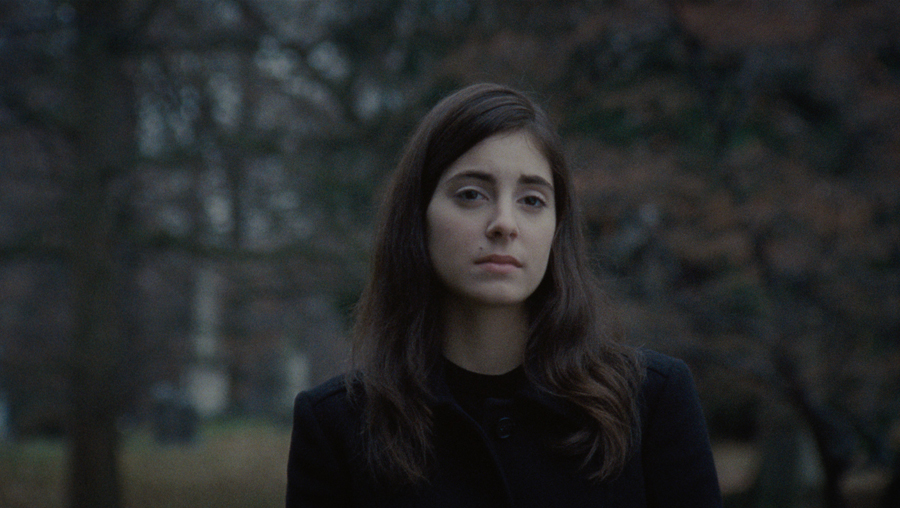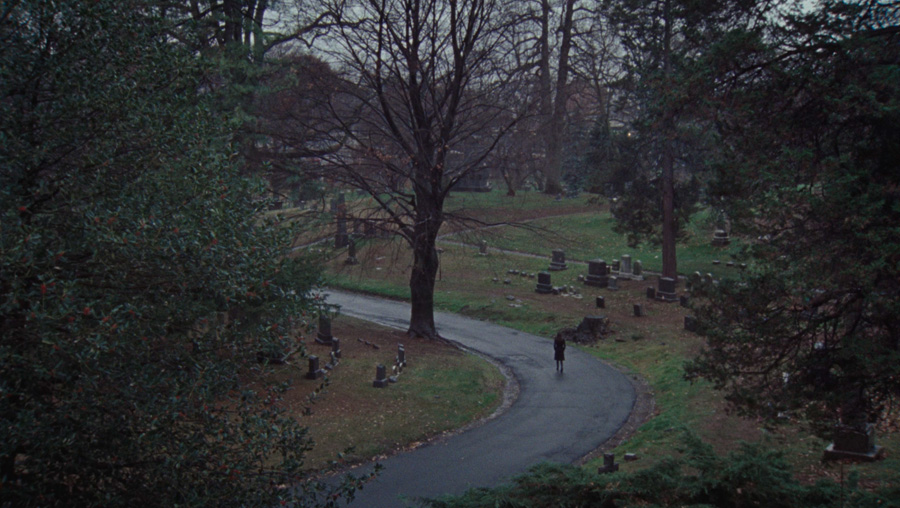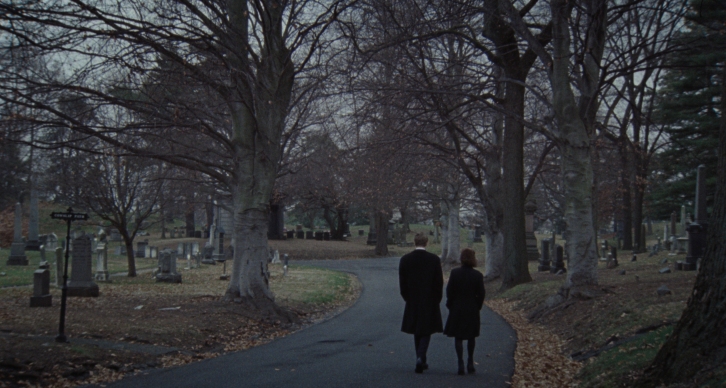Sophie Savides’ transcendent short The Funeral is an open question. Or really, a set of open questions. Is cinema about distance or closeness? The fictive or the real? Adhering to a rigorous three-part formalism, The Funeral isn’t about to provide any answers, which is an entirely appropriate approach to an achingly poetic depiction of a eulogy. Add one more question to the pile: who are eulogies for, anyway?
In what could be termed “Part One” of the seven-minute short, we watch a man and a woman walk down a winding graveyard path. It seems like a possibly brisk afternoon, as indicated by their overcoats and outfits and failing light. Post-film notes inform us The Funeral was shot in a single day in Greenwood Cemetery in Brooklyn, but it could be almost anywhere. The camera doesn’t move. For nearly two minutes, we watch them walk from above and behind; she puts her hand gently on his back. Eventually, they round a corner and disappear through the trees.

“Part Two” is another static shot, as lead actress Kristen Vaganos delivers a eulogy for her father, who recently passed after a two-year struggle with brain cancer. We see no other figures. Vaganos is isolated in the frame as she recounts aspects of her dad’s childhood, of her childhood. How he was shocked to find his own father was a fry-cook and not, as he had been told, the owner of a fancy restaurant. How he would let her stick her head out the window on car trips, and one time drove six hours to bring her the homework she forgot upstate. The camera imperceptibly moves as the monologue continues. Savides makes room for anger and irritation alongside the fond remembrances.
The Funeral closes on a “Part Three” of sorts. Vaganos turns and walks away, and our vantage shifts to an overhead shot similar to the one we started on. There is no one in the graveyard; there’s no audience for this eulogy. Except, of course, for us. Was she practicing? Did no one come, despite her spoken insistence that every one she ever met told her that her dad was their “best friend”? Once again, the camera refuses to move or elucidate. We watch her walk down that same path in reverse, and we fade to black.

It was only after The Funeral was over and the credits rolled that I realized Verganos was not one of the two people from the start. It was an establishing shot for physical context, not narrative per se. I had wondered why she would be the one consoling the man and not vice versa. But perhaps that’s still part of the point: her eulogy is a kind of consolation for listeners, even as it’s a reckoning for the speaker. The dead person, one assumes, doesn’t particularly care. There’s just a kind of vast emptiness that Savides’ insistent shots embody, and a resolute refusal to look away. It’s a brave telling.
As the daughter of legendary cinematographer Harris Savides, it’s hard not to read the treatment in autobiographical terms, especially as The Funeral is so formally attention-grabbing and imagistic. This was a guy who, before his passing in 2012, worked with — oh — Michel Gondry, Sophia Coppola, James Gray, Gus Van Sant, David Fincher, Noah Baumbach, and more, many of whom are thanked at the film’s end.
There’s an intensity to the young Savides’ short that speaks to a real familiarity with the image, the ways in which it allows and denies us entry: we start and finish with ambiguous distance, but in between are immersed in almost grueling intimacy. It’s an impressive way to film the story, and audiences could be forgiven for wondering exactly where this sensibility came from.
A few weeks ago, I attended a performance in San Francisco called “You’re Going To Die”. Structured as a recurring open mic, it features stories, poems, songs, and whatever else people feel like doing, all grappling with mortality. It was hard not to see the similarities: our protagonist in The Funeral could’ve been on that stage.
One crucial difference: the live theater aspect is absent. A eulogy on film is a life-line thrown into the abyss, but the formal aspects Savides emphasizes temper this desperation, turning an unflinching speech into a set of resonant images in conversation with each other.
I have no idea what comes next for the 22-year-old director, except for the logline on Le Cinema Club (where The Funeral is streaming for free until Saturday): her next project is, we are told, “a love story, imbued with Savides’ values and ideas about our modern society.” I can’t wait.

